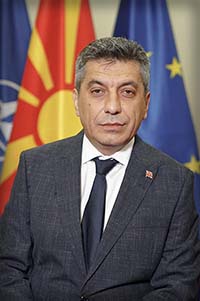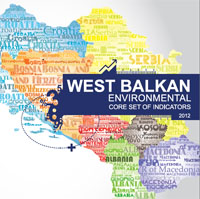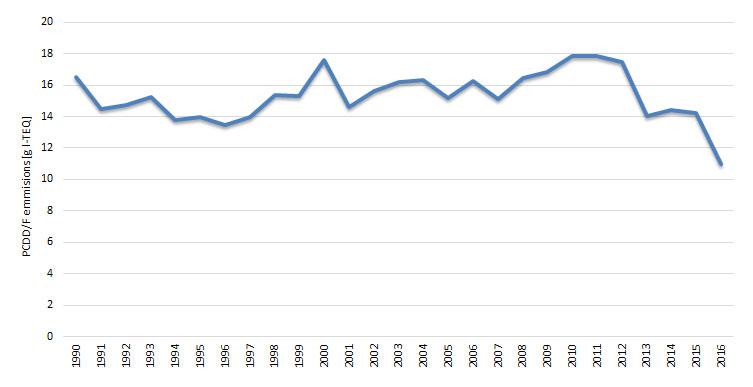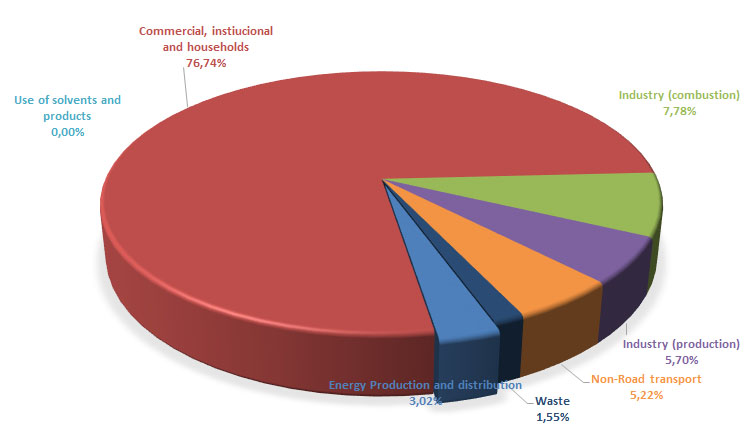| EMMISSION OF PERSISTENT ORGANIC POLLUTANTS – Dioxins and furans (PCDD/PCDF) |
The indicator tracks the trends indioxins and furans (Polychlorinated dibenzo-p-dioxins(PCDD) and dibenzofurans (PCDF)).
g I-TEQ (grams per toxic equivalent)
What progress has been made in overall reduction of emissions of dioxins and furans in the Republic of Macedonia?
In 1990, the overall national emissions of PCDD/PCDF (dioxins/furans) amounted to 16,5 g I-TEQ. Since then, emissions have been reduced to drop at 11 g I-TEQin 2016 or by 33% compared with 1990.
The Diagram below shows annual trend in dioxins and furans (PCDD/PCDF) emissions for the period 1990 to 2016.
Diagram 1.Trend in emissions of dioxins and furans (PCDD/PCDF)
Under the CARDS Programme, Inventory of air emissions of the main pollutants in the country was established in 2005 in accordance with the EMEP methodology by individual sectors, i.e. activities, and in 2014 Inventory including all pollutants was prepared.
Sectors based on the above mentioned methodology and SNAP – selective nomenclature of air pollution are presented in the table below:
| Sector |
| Energy Production and distribution |
| Commercial, instiucional and households |
| Industry (combustion) |
| Industry (production) |
| Fugitive emissions |
| Use of solvents and products |
| Road transport |
| Non-Road transport |
| Waste |
| Agriculture |
| Other |
The main source of PCDD/PCDF emissions in 2016 was the sector Commercial, institutional and householdswith a share of 76,7% (in the overall national emissions). Also, sectors Industry (combustion), Industry (production), Non-Road transport and Energy production and distribution contribute in o the overall national emissionsof PCDD/PCDF with shares of 7,8%, 5,7%, 5,2% and 3%, respectively.
Diagram 2. Emissions ofdioxins and furans (PCDD/PCDF) bysectors in 2016
Which different sectors and processes contribute to emissions of dioxins and furans (PCDD/PCDF)?
The main source of PCDD/PCDF emissions in the period 1990-2016 was the NFR category 1A4 – Other sectors (mainly household heating)and then 2 – Industrial processes and 1A2 Combustion from manufacturing industries and construction. In 2016 PCDD/PCDF emissions from NFR category 2 – Industrial processes are significant reduced compared to 2015 (by 59%) due to the change in the methodology of the emission calculation from subcategory Metal production (Production of iron and steel). Also, there is significant reducing in PCDD/PCDF emissions in 2016 compared to 2015 (by 22%) from NFR category 1A4 – Other sectors (mainly household heating).
NFR sectors 1B – Fugitive emissions, 3 – Agriculture and 5 – Waste were insignificant sources of PCDD/PCDF.
Diagram 3.Emissions of dioxins and furans (PCDD/PCDF) by NFR sectors per year
Data coverage: excel_1, excel_2
Sources of data: The data used refers to overall national emissions and emissions categorized by NFR delivered by EEA member and collaborating states to EEA and Secretariat of the United Nations. Data is accessible per country on the following web address:http://cdr.eionet.europa.eu/mk/un/clrtap/inventories/envwovm7g/.
- Methodology for indicator calculation
The methodology for this indicator calculation is based on calculated national emissions and emissions by NFR categories of this pollutant as reported to EEA (European Environmental Agency) and UNECE/EMEP (United Nations Economic Commission for Europe/Cooperative programme for monitoring and evaluation for transboundary air pollution transfer under the Convention on Transboundary Air Pollution Transfer) in February 2016. Data used in this report is in accordance with the data submitted, the difference being that additional allocation of national emissions has been made apart from NFR (as sent to international organizations) also by SNAP.
Calculations are in line with the Guidebook of EMEP/EEA on air emissions inventory taking published in 2009, 2013 and 2016.
Methodology used for calculation and presentation of this indicator is given in EMEP/EEA Guidebook for inventory of air pollutant emissions of 2009, Guidebook of 2013 and Guidebook of 2016 which may be accessed at the following links http://www.eea.europa.eu/publications/emep-eea-emission-inventory-guidebook-2009, http://www.eea.europa.eu/publications/emep-eea-emission-inventory-guidebook-2013 and http://www.eea.europa.eu/publications/emep-eea-guidebook-2016).
Action Plan for European Partnership, as well as National Plan for approximation of the national legislation with European regulations specifying bylaws that need to be prepared have been adopted.
The National Environmental Action Plan (NEAP II) was adopted. It contains the measures that need to be taken to improve the overall status of air quality, including the reduction of emissions of acidifying substances. The National Plan for Ambient Air Protection for the period 2012 to 2017 specifying the measures for air protection on national level and the National Programme for gradual air emissions reduction by 2020 have been adopted in order to define and implement measures on national level.
Does any of the national documents set target or target should be achieved in accordance with other international documents?
National strategic documents listed as references in the above text provide guidelines and specify actions that should be undertaken as a matter of priority. It is important to mention thatbylaws have been prepared in the area of air emissions transposing Directives 96/61/EC, 2000/81/EC, 2000/76/EC, 99/13/EC and 2001/81/EC, ranging between 90 and 100%.
In accordance with the requirements of the UNECE Convention on Long-Range Transboundary Air Pollution, inventory based on EMEP/EEA Guidebook for inventory of polluting substances into the air, setting the target of regular inventory of pollutants in tons per year following the n-2 principle, where n is the current year. For this polluting substance, limit values of air emissions are set in the bylaw which is compliant with the following directives: 2001/80/ЕC, 1999/13/EC and 2000/76/EC.
Also, targets – basic obligations for this polluting substance are also set in the Protocol to the 1979 UNECE Convention on Long-Range Transboundary Air Pollution concerning persistent organic pollutants, ratified in our country in 2010 (Official Gazette of RM no.135/2010).
Under the Protocol, national overall emissions of PCDD/PCDF in n-2 year (where n is the current year) should not exceed the overall emission calculated for 1990 (taken as baseline year). The Republic of Macedonia is in compliance with this Protocol considering the emissions presented here for 2016. Compared to 1990, emissions of this pollutant have been reduced by 33%.
Legal basis
The Law on Ambient Air Quality adopted in August 2004 and amended several times afterwards (Official Gazette of RM no. 67/2004, 92/2007, 83/2009, 35/10, 47/11, 100/12, 163/2013, 10/2015 и 146/2015) is framework law in the area of air. The goals of this Law include avoiding, prevention and reduction of harmful effects on human health and environment as a whole, prevention and abatement of pollutions leading to climate change, as well as provision of appropriate information on the quality of ambient air.
On the basis of the Law on Ambient Air Quality, 16 bylaws were prepared and adopted to introduce limit values for air quality and air emissions, methodology of air quality and air emissions monitoring, manner of preparation of planning documents for air protection against pollution, manner of informing the citizens and international organizations, etc.
In relation to the obligations for calculation of the emissions of dioxins and furans (PCDD/PCDF), the following convention and protocol as international ratified agreements are of relevance:
Stockholm Convention on Persistent Organic Pollutants ratified by the Law on Ratification (Official Gazette of RM no. 17/2004).
Protocol to the 1979 UNECE Convention on Long-Range Transboundary Air Pollution concerning persistent organic pollutants, ratified in our country in 2010 (Official Gazette of RM no.135/2010).
- Reporting obligations towards international agreements – UNECE-CLRTAP and ЕЕА
- Annual Report of Processed Data on Air Emissions
| Code | Title of the indicator | Compliance with CSI ЕЕА or other indicators | Classification by DPSIR | Type | Linkage with area | Frequency of publication | |
| MK NI 062 | Emissions of persistent organic pollutants – dioxins and furans (PCDD/PCDF) | EEA
UNECE |
APE 006
A1/11 |
P | B |
|
annually |








































































